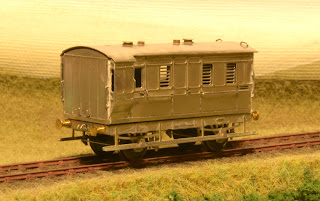As well as the signal cabin, the previous post showed my first (almost-) completed loco, a Drummond 0-6-4T "banking tank". This has been my main modelling project for the last few months, and I'm happy with how it has come together. As you can see, it still needs crankpin washers (I can't find the packet which I'm fairly sure I bought years ago from the 2mm shop!), transfers (I've drawn the artwork for these but am waiting for them to be produced), vacuum pipes, and tablet capture apparatus on the cab sides.
Below is a view of the chassis as it stands - the next step here is to fit a decoder, which will probably go in the coal bunker. Running is not bad, and hopefully will improve with running in a bit more. I've weighed the body down with some chunks of lead in the side tanks and the front of the boiler, but it looks like I might need a bit of weight at the rear end too - I'm not sure.
The motor is an Association flat can, driving through a 30:1 worm and a 14:25 reduction with M0.3 spur gears to the central driving axle.
The bogie was made in a similar way, i.e. with the sideframes cut out by hand and a PCB spacer. As you see in this top view, they have a tab that folds up on to the PCB - this is to provide a bearing surface for the spring-cum-pick up that bears down on the bogie from the main chassis. In the centre of the bogie (top and bottom) there is a square brass washer with a hole for the fixing screw. The bogie is free to slide up and down on this screw. In fact, the hole is elongated sideways, in order to give the bogie a bit of sideplay (this is limited as I didn't allow much width in the centre section of the spacer!). The screw itself is just a 12BA bolt with a length of brass tube soldered on. Another length of brass tubing is soldered into a hole through the main chassis (see picture below), and finally a nut soldered on top.
The body itself was made from my own etch, although this didn't include the boiler or any of the various details. The etched cab roof turned out to be too flimsy so I made a new one from 10 thou material. In the photo at the top you can see that this is still loose and might be glued down once I am happy it is running ok and have fitted the decoder etc. The boiler furniture represent my first attempt at turning these items on the lathe, and I was pleasantly surprised with how straightforward these were (although they are not 100% dimensionally accurate!).
























